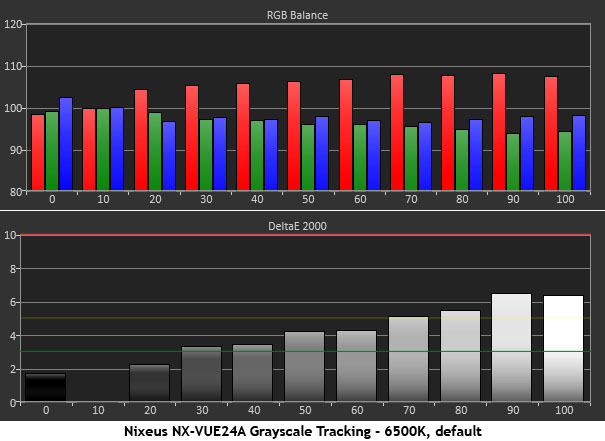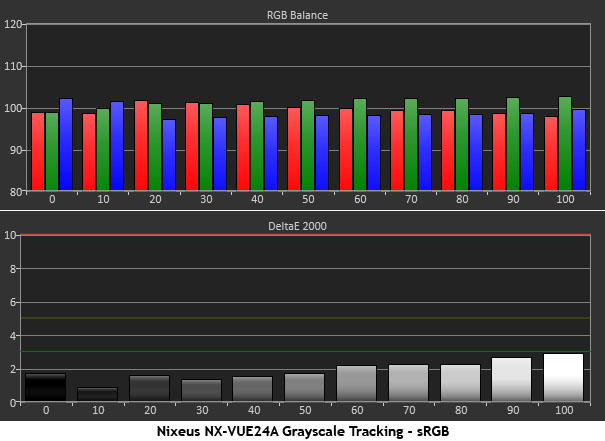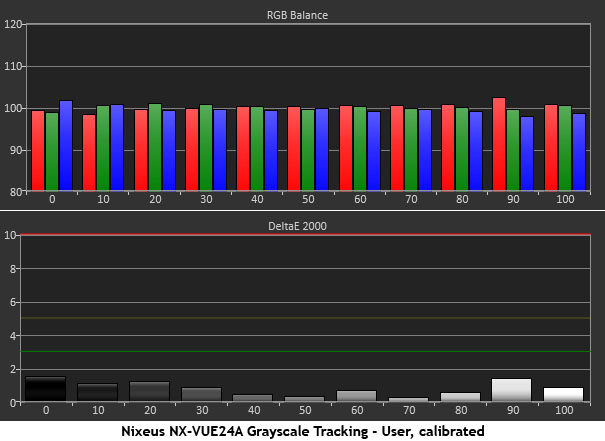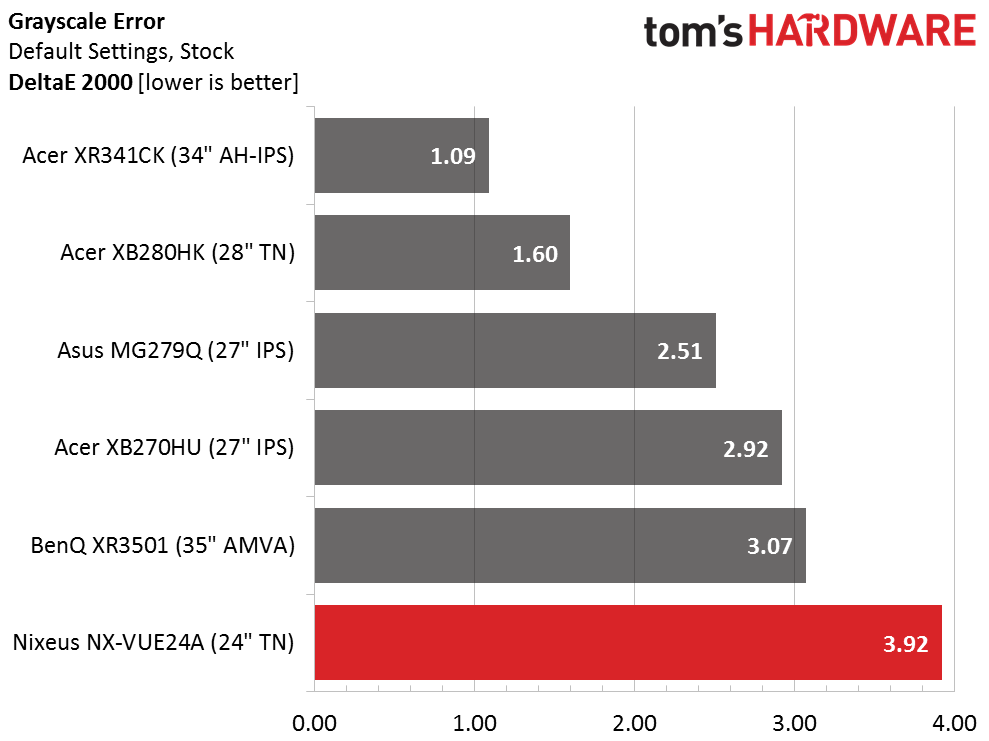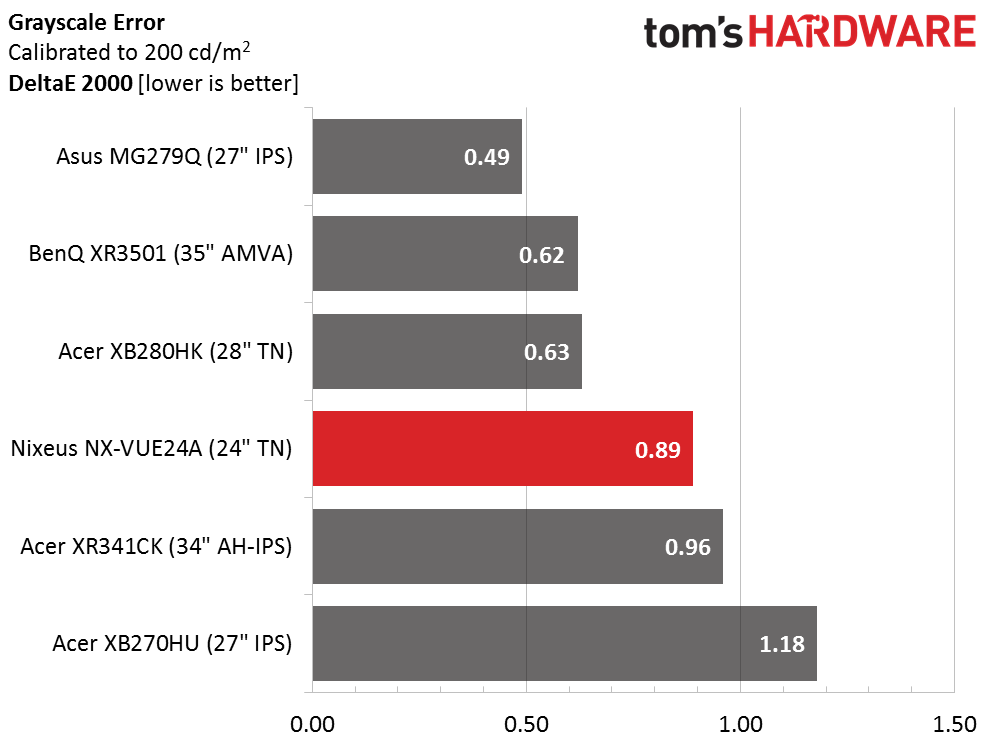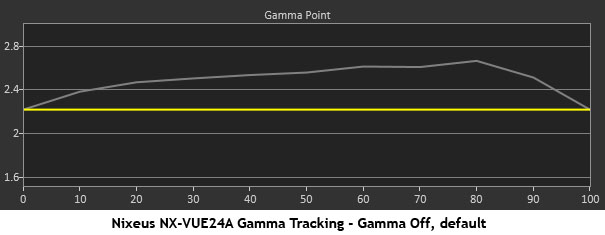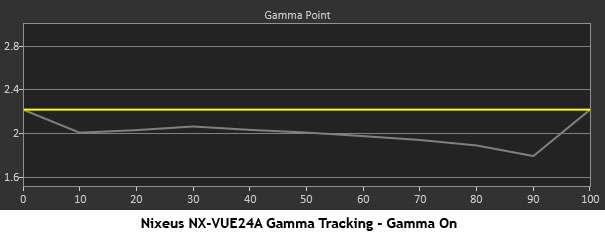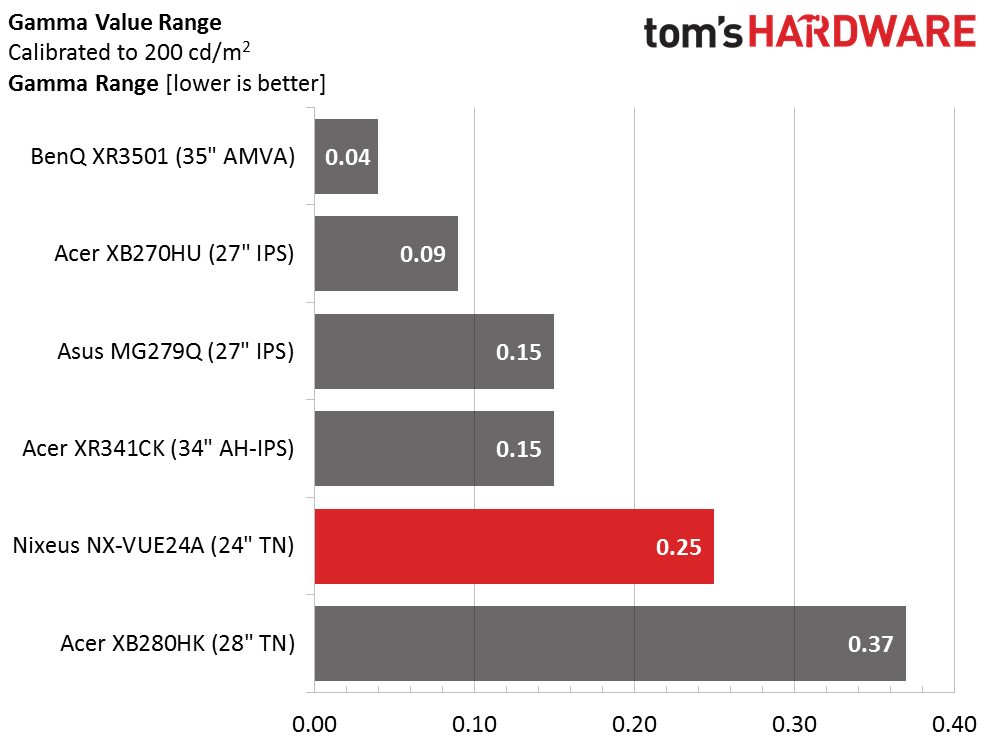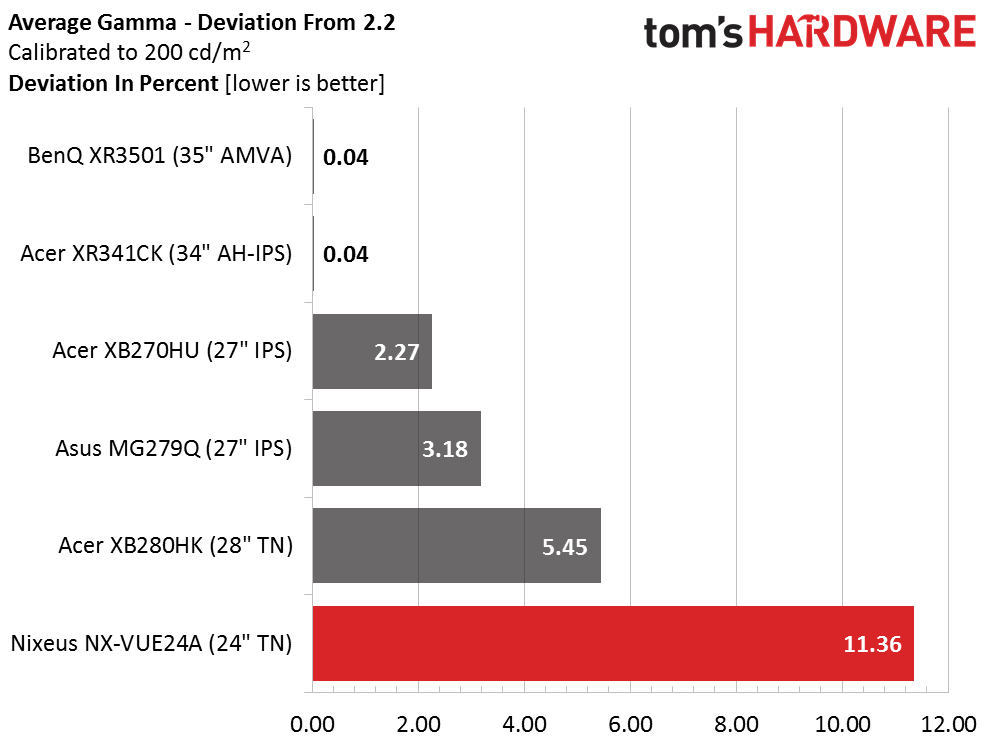Nixeus NX-VUE24A Monitor Review
FreeSync and G-Sync monitors are selling at a premium but Nixeus breaks that trend with a value-priced 24-inch model the runs FreeSync from 30 to 144Hz. Today we check out the NX-VUE24A.
Why you can trust Tom's Hardware
Grayscale Tracking And Gamma Response
Our grayscale and gamma tests are described in detail here.
6500K is the default color mode and as you can see it’s visibly red at 30-percent brightness and higher. Simply switching to the cooler 9300K option won’t cut it as that takes you into a very blue/green situation. You have two possible fixes at your disposal, sRGB mode and User Define.
sRGB mode is quite good with no visible errors present. The above measurements were taken with Gamma turned off. Switching it on lightens the image but also introduces green errors. The overall error here is much better at 1.94dE.
Turning on Gamma and calibrating the white point produces the best result. We’ll explain the gamma options more below but suffice it to say you’ll want to turn it on and plug in our recommended RGB values at the very least. Better yet, calibrate the NX-VUE24A yourself if you have the means. It is capable of decent accuracy.
Here is our comparison group.
The warm color temp drops the Nixeus to last place in the out-of-box comparison. While switching to sRGB mode will improve the error level significantly, we recommend calibration for the very best accuracy.
As you can see, calibration is well worth the effort. A .89dE result is comparable to many professional screens. We’re liking the NX-VUE24A’s color accuracy so far but the one thing we couldn’t completely fix was its gamma tracking.
Get Tom's Hardware's best news and in-depth reviews, straight to your inbox.
Gamma Response
Nixeus has provided two gamma options, On and Off. By default it’s Off and this rather dark curve is the result. The picture looks a bit drab in this state and color gamut accuracy suffers too. If there were more backlight output available it would be possible to run with this gamma result but ultimately, Nixeus should fix this issue so tracking is more in line with the 2.2 standard.
Turning Gamma On drops the curve below 2.2 which lightens up the image considerably. It’s the lesser of two evils and we ultimately settled on this setting as our preference. Grayscale tracking is affected by this so we suggest choosing your Gamma option before making further adjustments.
Here is our comparison group again.
With a .25 variation in gamma values from smallest to largest, the NX-VUE24A has definite room for improvement. The only way to work around this would be to use a software look-up table from an application like CalMAN. Without that, the above is as good as it gets.
We calculate gamma deviation by simply expressing the difference from 2.2 as a percentage.
With an average value of just 1.95, the Nixeus is well off the 2.2 standard. That being said, we still prefer the lighter option (Gamma On). There is no evidence of detail crush in either shadows or highlights. The image just isn’t quite as good as it could be if the gamma were more accurate.
Current page: Grayscale Tracking And Gamma Response
Prev Page Brightness And Contrast Next Page Color Gamut And Performance
Christian Eberle is a Contributing Editor for Tom's Hardware US. He's a veteran reviewer of A/V equipment, specializing in monitors. Christian began his obsession with tech when he built his first PC in 1991, a 286 running DOS 3.0 at a blazing 12MHz. In 2006, he undertook training from the Imaging Science Foundation in video calibration and testing and thus started a passion for precise imaging that persists to this day. He is also a professional musician with a degree from the New England Conservatory as a classical bassoonist which he used to good effect as a performer with the West Point Army Band from 1987 to 2013. He enjoys watching movies and listening to high-end audio in his custom-built home theater and can be seen riding trails near his home on a race-ready ICE VTX recumbent trike. Christian enjoys the endless summer in Florida where he lives with his wife and Chihuahua and plays with orchestras around the state.
-
iam2thecrowe Just cant wait for the day where every monitor is freesync/gsync and dont have to toss up between features/price/panel quality so much to find what suits me best.Reply -
thor220 It's good to see Free-Sync monitors getting larger ranges, especially at this price point. I'm waiting for one's that can use the full Free-Sync spec down into the single digit FPS, that way even people with entry level cards will be able to benefit from this technology.Reply
No USB isn't a huge deal for 99% of the people and I don't think it should really be a strike against this monitor. Sure it's present on higher end models but who's to say that contributes to a monitor's worth in the first place? USB hubs are so cheap, I don't think anyone uses USB as a metric for picking a monitor.
While they did fudge the brightness number, this monitor can still go above safe brightness settings. Unless you need to burn out your eyes, most people won't even notice it.
Perplexed as to why "TN Panel" is listed as a con when in this very review it's stated that being a TN panel isn't indicative of poor quality or color. This monitor has good color, especially considering it's a gaming monitor. -
photonboy thor220,Reply
As said "viewing angles" are one drawback. As for color, the TN may not be "poor" but it is not as good as IPS (IPS has drawbacks like more ghosting though).
Other:
It should be "LCD panel" not "LED panel" in the article. It is an LED monitor but that just refers to the choice of backlight. The "panel" is the IPS, TN or other technology that filters the backlight to produce individual pixels. -
crisan_tiberiu Thor220, i dont know about the range of freesync and gsync on the low side, but under 24 Hz the slideshow effect kicks in. It is all about the human eye.Reply -
iam2thecrowe Reply
Coming from a TN panel to a VA panel, i would never go back to TN. Considering recent VA and IPS panels have low response (not quite as low as TN but good enough to minimize ghosting/blur), low input lag and high refresh rate capabilities, I would say they are now preferable over TN, but a premium price is normally paid. Maybe some competitive gamers may see TN as preferable for lower response times, but i would say most gamers aren't on a competitive level and can enjoy the higher image quality of a VA or IPS panel.16877315 said:Perplexed as to why "TN Panel" is listed as a con when in this very review it's stated that being a TN panel isn't indicative of poor quality or color. This monitor has good color, especially considering it's a gaming monitor. -
quilciri response time and ghosting are separate issues. Refresh rate helps with ghosting, but response time does not. IPS/PLS panels are unfortunately not as good as TN (on average) with ghosting and overshoot (and of course, response time).Reply
http://www.tftcentral.co.uk/articles/response_time.htm
http://www.tftcentral.co.uk/articles/motion_blur.htm
Both technologies have not yet achieved the gold standard of response an motion clarity that was CRT, though :D
-
DongleKin If you want to test freesync at low frame rates, just underclock the graphics card until you're in the 30s of FPS.Reply -
milkod2001 Unless you are professional FPS gamer who really needs very fast response times you might be better served with 27' 1440 PLS korean imports for the same price.Reply
Bigger screen and resolution not to mention colours.
This monitor would be great if sold under $200. $350 for TN 1080p panel even with fast response time is a joke. -
quilciri Reply16881305 said:Unless you are professional FPS gamer who really needs very fast response times you might be better served with 27' 1440 PLS korean imports for the same price.
Bigger screen and resolution not to mention colours.
This monitor would be great if sold under $200. $350 for TN 1080p panel even with fast response time is a joke.
The Last widely manufactured overclockable Korean IPS, the QNIX 2710, has issues; one of which is being hit or miss when overclocking and getting the true frame rate you've overclocked to vs. skipping frames. It also has significant ghosting and overshoot. It's a good monitor, but definitely has compromises. "you get what you pay for" is true here.
http://www.tftcentral.co.uk/reviews/qnix_qx2710.htm
...it's a damn shame about overlord computers; I hope Scribby recovers. Even so, I don't think the company was going to be around much longer with the falling prices of 120hz+ adaptive sync monitors.
That reminds me... Manufacturer refurb'd Acer XG270HU's are on Ebay from the Acer store for $330 & free shipping right now. I totally bought one then posted on slickdeals :)
